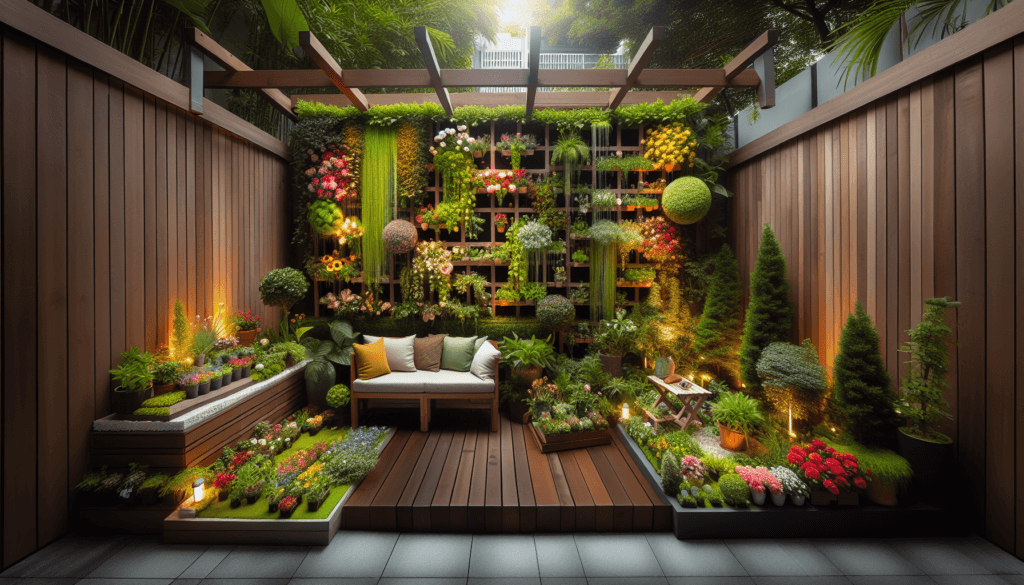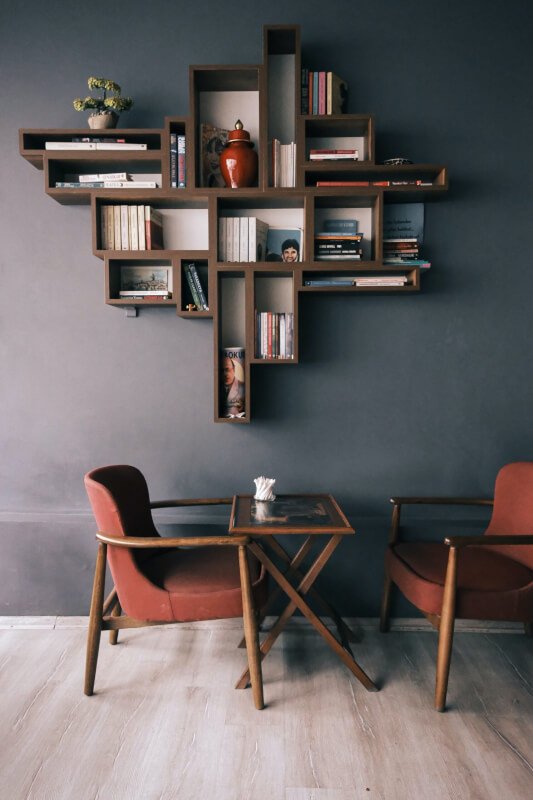Creating a stunning and functional garden in a limited space doesn’t have to be a daunting task. Whether you have a tiny balcony or a petite backyard, there are plenty of creative ways to transform your small garden into an inviting oasis. In this article, we will explore some of the best strategies and design ideas to make the most of your compact outdoor space. From vertical gardens to clever storage solutions, get ready to discover the secrets to designing a small garden that will leave you and your guests in awe.
Choosing the Right Plants
Consider the Size and Growth Habit
When designing a small garden, it is crucial to choose plants that are suitable for the space available. Consider the size and growth habit of the plants to ensure they will not overshadow or overwhelm the garden. Opt for plants that stay compact and have a controlled growth habit, as this will prevent them from outgrowing their assigned area and taking over the entire garden. By carefully selecting plants that are proportionate to the space, you can create a garden that feels balanced and harmonious.
Opt for Compact and Dwarf Varieties
In a small garden, it is advisable to choose compact and dwarf varieties of plants. These plants are specifically bred to stay small, making them ideal for limited spaces. Compact varieties of popular plants such as roses, hydrangeas, and fruit trees are available in the market. These plants provide all the beauty and benefits of their full-sized counterparts while taking up less space. Opting for compact and dwarf varieties allows you to enjoy a wide range of plants without overcrowding your garden.
Use Vertical Gardening Techniques
Utilizing vertical gardening techniques is a smart way to maximize the space in a small garden. By growing plants vertically, you can take advantage of the vertical space available, making room for more plants and adding visual interest to your garden. Vertical gardening can be achieved through the use of trellises, arbors, or wall-mounted planters. Vines, such as ivy and climbing roses, are excellent choices for vertical gardening as they can add height and texture to the garden without taking up much ground space.
Include Plants with Multiple Purposes
To make the most of a small garden, consider incorporating plants that serve multiple purposes. For example, certain herbs are not only great for culinary purposes but also have beautiful foliage or fragrant flowers. Similarly, some flowering plants attract pollinators, while also providing color and visual appeal to the garden. By selecting plants that have more than one use, you can create a garden that is both functional and aesthetically pleasing.
Prioritize Low-Maintenance Plants
In a small garden, it is essential to prioritize low-maintenance plants. Opting for plants that require minimal care will save you time and effort in the long run. Look for plants that are well-suited to your local climate and soil conditions, as they will be more likely to thrive with minimal intervention. Additionally, choose plants that have a low water requirement, as this will reduce the need for frequent watering. Prioritizing low-maintenance plants will allow you to enjoy your garden without feeling overwhelmed by the upkeep.
Creating Zones and Structures
Divide the Space into Functional Zones
When designing a small garden, dividing the space into functional zones can help maximize its usability. Consider how you plan to use the garden and identify the different activities or features you want to incorporate. For example, you may want to have a seating area, a dining area, and a play area for children. By creating distinct zones, you can effectively organize the space and make it more enjoyable and efficient to use.
Incorporate Pathways and Paving
In a small garden, pathways and paving can serve multiple purposes. Not only do they provide a practical way to navigate through the garden, but they can also add visual interest and define different areas. Consider using materials like gravel, stepping stones, or brick pavers to create pathways and paving. These materials are cost-effective and can be easily installed in small spaces. By incorporating pathways and paving, you can enhance the structure and accessibility of your garden.
Add Vertical Structures for Interest
Vertical structures such as trellises, pergolas, or arches can add verticality and architectural interest to a small garden. These structures not only provide support for climbing plants but also create a sense of height and depth in the garden. When choosing vertical structures, opt for those that are proportionate to the size of your garden and complement its overall design. By adding vertical structures, you can make your small garden feel more visually appealing and dynamic.
Utilize Containers and Raised Beds
Containers and raised beds are excellent solutions for small gardens as they allow you to cultivate plants in a confined space. Containers come in various shapes and sizes, making them versatile for any garden design. They can be placed on patios, balconies, or small corners of the garden. Raised beds, on the other hand, provide a defined area for planting and can be customized to fit the size and shape of your garden. Utilizing containers and raised beds not only maximizes the available space but also makes it easier to maintain and care for your plants.
Install a Small Water Feature
Adding a small water feature to your small garden can create a tranquil and soothing atmosphere. A compact fountain, cascading waterfall, or even a miniature pond can bring life and serenity to your outdoor space. The gentle sound of flowing water has a calming effect and can help mask unwanted noises from the surrounding environment. In addition to the aesthetic appeal, a water feature can also attract birds, butterflies, and other wildlife, enhancing the overall biodiversity of your garden.

Maximizing Space with Smart Design
Utilize Vertical Space for Planters and Shelving
Vertical space often goes unused in small gardens, but it can be maximized by utilizing planters and shelving. Install wall-mounted planters or hanging baskets to grow flowers, herbs, or small vegetables. These planters not only save valuable ground space but also add visual interest to your garden walls. Additionally, consider installing shelves or racks to create a vertical garden for potted plants or other gardening essentials. By utilizing vertical space, you can make your small garden more functional and visually appealing.
Create a Sense of Depth with Layers
In a small garden, creating a sense of depth is essential to make the space appear larger and more inviting. Layer different elements such as plants, shrubs, and hardscape features to achieve this effect. Place taller plants or shrubs at the back of the garden and gradually decrease their heights towards the front. Incorporate different textures, colors, and shapes to add interest and depth to the garden. By creating layers, you can visually expand the space and make it feel more expansive.
Opt for Compact and Foldable Furniture
When it comes to selecting furniture for a small garden, opt for compact and foldable options. Compact furniture is designed to fit smaller spaces without sacrificing functionality or comfort. Look for folding chairs, collapsible tables, or benches that can be easily stored when not in use. Additionally, choose furniture with built-in storage compartments to maximize space efficiency. By selecting compact and foldable furniture, you can create a flexible outdoor space that can be easily adapted to your needs.
Use Mirrors to Create Illusion of Space
Mirrors are a clever trick to create an illusion of space in a small garden. Reflective surfaces can visually expand the area by bouncing light and creating the perception of depth. Install a mirror strategically on a garden wall or fence to create a focal point and give the impression of a larger garden. Mirrors also help to bring more light into darker corners of the garden, making it feel brighter and more open. However, be mindful of the placement to avoid overly reflecting direct sunlight and causing glare.
Incorporate Hanging Plants and Wall Gardens
Hanging plants and wall gardens are excellent additions to a small garden as they take advantage of vertical space while adding a touch of charm and beauty. Hang baskets filled with colorful flowers or trailing vines from pergolas, trees, or trellises. This not only adds visual interest but also frees up valuable ground space. Wall gardens, created using vertical planters or living walls, offer a unique way to incorporate greenery into your garden design. By incorporating hanging plants and wall gardens, you can transform ordinary vertical spaces into vibrant and lush focal points.
Designing with Color and Texture
Choose a Cohesive Color Scheme
When designing a small garden, choosing a cohesive color scheme can have a significant impact on the overall aesthetics. Opt for a limited palette of colors that complement each other and create a harmonious look. Consider the colors of your existing structures, such as fences or walls, and select plants that will enhance or contrast with them. Soft pastel colors like lavender and baby blue can create a calming and sophisticated atmosphere, while bright, bold colors like red and yellow can add vibrancy and energy to the garden.
Create Contrast with Different Textures
Incorporating plants with different textures is a great way to add visual interest and depth to a small garden. Combine plants with glossy leaves, such as palms or hostas, with those that have fine, feathery foliage like ferns or ornamental grasses. This contrast in textures creates a dynamic and layered look. Additionally, mix in rough-textured elements like rocks, pebbles, or bark to add further dimension to the garden. By creating contrast with different textures, you can make your small garden feel more diverse and visually captivating.
Play with Foliage Shapes and Sizes
While flowers often steal the spotlight, foliage plays a vital role in garden design. In a small garden, where space is limited, using plants with interesting foliage shapes and sizes can make a significant visual impact. Choose plants with varying leaf shapes, such as broad and palmate leaves or delicate and lacy foliage. Incorporate plants with different heights to create a pleasing rhythm in your garden design. By playing with foliage shapes and sizes, you can add texture, depth, and variety to your small garden.
Add Colorful Accents and Accessories
In addition to plants, incorporating colorful accents and accessories can elevate the design of a small garden. Use colorful pots, decorative planters, or vibrant garden furniture to add pops of color and create focal points. Consider using brightly colored cushions, throws, or outdoor rugs to add a touch of personality and make the space feel cozy and inviting. By strategically placing colorful accents and accessories, you can add visual interest and inject your personal style into your small garden.
Introduce Patterns through Tiles or Fabrics
Introducing patterns through tiles or fabrics can add a decorative touch to a small garden. Use patterned tiles on your patio or create a mosaic pathway to add visual interest and create a focal point. Incorporate patterned fabrics in cushions, curtains, or tablecloths to bring a sense of liveliness and style. The use of patterns can help break up monotonous spaces and make your small garden feel more vibrant and dynamic. However, be mindful not to overwhelm the space with too many patterns, as this can make it feel cluttered and chaotic.
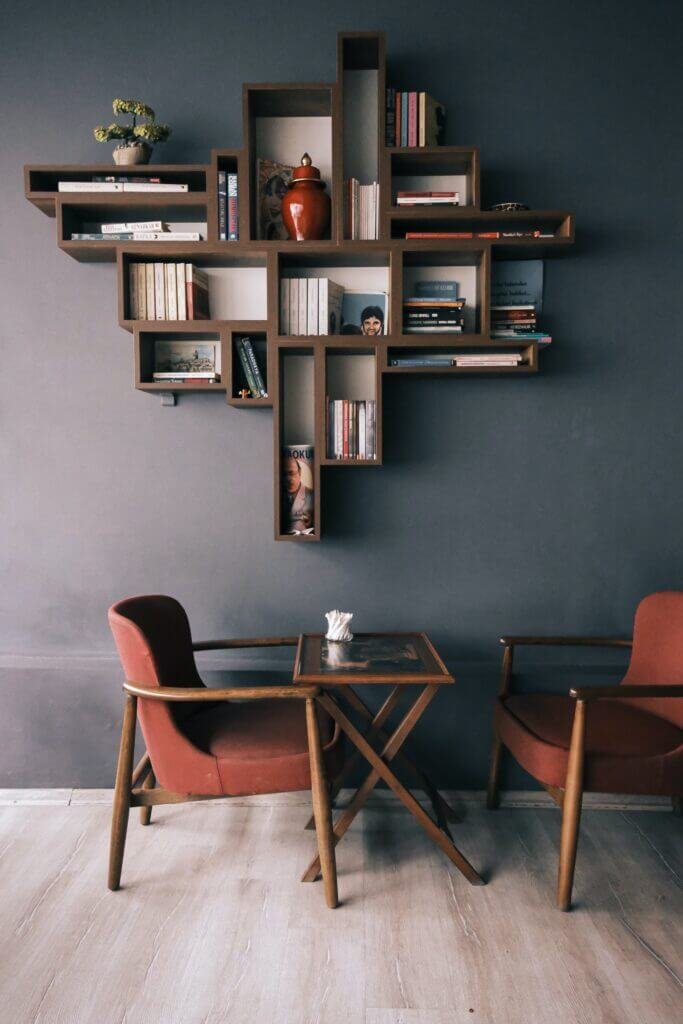
Enhancing with Lighting and Mirrors
Install Ambient Lighting for Evening Enjoyment
Proper lighting is essential in a small garden to enhance its beauty even after the sun goes down. Install ambient lighting, such as string lights, lanterns, or spotlights, to create a warm and inviting atmosphere in the evenings. String lights can be hung across patio areas or along fences to create a soft and magical glow. Lanterns and spotlights can be strategically placed to highlight key features, such as fountains or sculptures. By installing ambient lighting, you can extend the usability of your small garden and create a cozy ambiance for evening enjoyment.
Highlight Key Features with Accent Lights
In addition to ambient lighting, using accent lights to highlight key features can create a dramatic effect in a small garden. Consider installing spotlights or uplights to illuminate focal points like trees, statues, or architectural elements. These accent lights can create a stunning play of light and shadow, adding depth and creating a focal point in the garden. By highlighting key features with accent lights, you can draw attention to specific areas and enhance the overall visual appeal of your small garden.
Use Solar-Powered Lighting for Energy Efficiency
When designing a small garden, it is important to consider energy efficiency. Solar-powered lighting is an excellent choice as it harnesses the natural energy from the sun and eliminates the need for electrical wiring. Install solar-powered lights along pathways, in planters, or within garden structures to provide illumination without adding to your electricity costs. Solar-powered lighting is not only environmentally friendly but also easy to install and maintain, making it a practical and sustainable choice for a small garden.
Strategically Place Mirrors for Reflections
Mirrors not only add an illusion of space, but they can also reflect light and create interesting visual effects in a small garden. Strategically place mirrors on fences or walls to reflect specific areas or to bounce light into darker corners. Mirrors can also be positioned to create the illusion of depth and make the garden seem larger than it is. However, be cautious with the placement of mirrors to avoid creating an artificial or disorienting effect. By strategically placing mirrors, you can maximize the available light and create captivating reflections in your small garden.
Include String Lights or Lanterns for a Cozy Atmosphere
String lights and lanterns are excellent additions to a small garden, as they create a cozy and intimate atmosphere. Hang string lights across fences or pergolas to provide a warm and enchanting glow. Use lanterns to create pools of light in seating areas or around pathways. The soft and flickering light from string lights and lanterns can evoke a sense of romance and tranquility, making your small garden a perfect spot for relaxation and entertaining. By including string lights or lanterns, you can transform your small garden into a magical oasis.
Adding Functional Features
Incorporate a Seating Area for Relaxation
No garden is complete without a cozy seating area where you can relax and unwind. In a small garden, it is important to choose furniture that is proportionate to the space. Opt for compact and multifunctional furniture, such as foldable chairs or benches with built-in storage. Arrange the seating area in a way that maximizes the available space and allows for easy movement. Consider adding comfortable cushions or outdoor rugs to create a welcoming and comfortable environment. By incorporating a seating area, you can make your small garden a place of tranquility and enjoyment.
Include Space for Outdoor Dining
In a small garden, incorporating space for outdoor dining adds functionality and allows you to make the most of your outdoor space. Choose a dining set that is compact and easily collapsible, so it can be stored when not in use. Consider integrating a small bistro table or a wall-mounted table that can be folded down when needed. By including space for outdoor dining, you can enjoy al fresco meals and entertaining without sacrificing valuable garden space.
Integrate a BBQ or Outdoor Kitchen
For those who enjoy outdoor cooking and entertaining, integrating a BBQ or outdoor kitchen into a small garden is a great option. Choose a compact and portable BBQ grill that can be easily moved or stored. Alternatively, consider building a small outdoor kitchen with a countertop, sink, and storage space. This allows you to have all the necessary tools and equipment within reach while maximizing the available space. By integrating a BBQ or outdoor kitchen, you can elevate your small garden into a culinary haven.
Create a Play Area for Children
If you have children or grandchildren, creating a play area in your small garden can be a wonderful addition. Consider installing a swing set, a small sandbox, or a playhouse that is proportionate to the space available. Make sure the play area is securely fenced and child-friendly, with soft ground coverings to cushion falls. By designing a play area, you can encourage outdoor play and create lasting memories for the little ones in your life.
Install Storage Solutions for Garden Tools
To keep your small garden organized and clutter-free, it is essential to have adequate storage solutions for garden tools. Install hooks or racks on the walls or fences to hang small tools such as trowels, shears, or gloves. Utilize compact storage cabinets or sheds to stow larger equipment like lawnmowers or hedge trimmers. Consider incorporating hidden storage compartments in seating benches or raised beds to keep gardening essentials within reach while maintaining a tidy and organized garden. By installing storage solutions, you can ensure a well-maintained and efficient small garden.
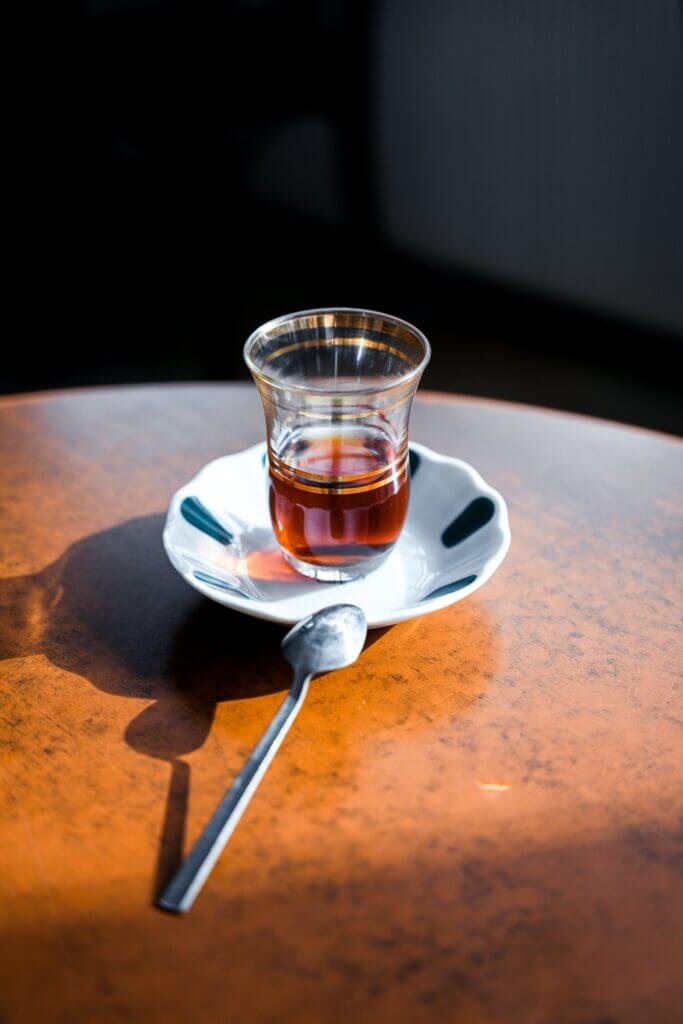
Attracting Wildlife
Plant Native Flowers to Attract Pollinators
One way to enhance biodiversity in your small garden is by planting native flowers that attract pollinators like bees, butterflies, and hummingbirds. Native flowers have evolved alongside local pollinators and provide nourishment and habitat. Choose a variety of flowers that bloom at different times, ensuring a continuous source of nectar throughout the seasons. Incorporate flowering plants with different shapes and colors to attract a diverse range of pollinators. By planting native flowers, you can create a vibrant and ecologically-friendly garden.
Provide Water Sources for Birds and Bees
To attract and support wildlife in your small garden, it is crucial to provide water sources for birds and bees. Install bird baths or shallow dishes filled with water for birds to drink and bathe in. Be sure to change the water regularly to prevent mosquitos from breeding. Additionally, place shallow bowls or dishes filled with water and pebbles for bees and butterflies to safely drink from. By providing water sources, you can create an inviting habitat for wildlife and contribute to their well-being.
Include Nesting Boxes or Bird Feeders
To encourage birds to visit and nest in your small garden, consider installing nesting boxes or bird feeders. Nesting boxes provide shelter and safe havens for birds to lay their eggs and raise their young. Place them in a secure location, away from predators and strong winds. Bird feeders, on the other hand, provide a source of food for birds, especially during the colder months when natural food sources may be scarce. By including nesting boxes or bird feeders, you can attract and support a diverse range of birds in your small garden.
Create Shelters for Beneficial Insects
Beneficial insects, such as ladybugs and lacewings, play an essential role in maintaining a healthy garden ecosystem by preying on pests. To encourage these helpful insects to take up residence in your small garden, create shelters and habitats for them. Install insect hotels or bug boxes filled with materials like bamboo, hollow stems, or straw to provide nesting sites for beneficial insects. Additionally, incorporate native plants that attract beneficial insects with their nectar and pollen. By creating shelters for beneficial insects, you can naturally control pest populations and maintain a balanced ecosystem.
Integrate a Small Pond for Aquatic Life
If space permits, integrating a small pond into your small garden can provide a habitat for aquatic life and create a serene focal point. Choose a pond liner or pre-formed pond that fits the available space. Incorporate water plants such as water lilies or floating plants to provide shade and oxygenation while adding beauty to the pond. Consider installing a small fountain or a water feature to create movement and a pleasing sound. A pond can attract frogs, dragonflies, and other water-dwelling creatures, adding a touch of tranquility and enhancing the biodiversity in your garden.
Choosing Decorative Elements
Select Eye-Catching Garden Ornaments
Incorporating eye-catching garden ornaments can add personality and charm to a small garden. Choose ornaments that reflect your personal style and complement the overall design of your garden. Opt for sculptures, statues, or artistic metalwork that can serve as focal points. Select ornaments that are proportionate to the size of your garden to avoid overwhelming the space. By carefully selecting eye-catching garden ornaments, you can add visual interest and showcase your individuality in your small garden.
Incorporate Sculptures or Artwork
Sculptures or artwork can add a touch of sophistication and elegance to a small garden. Consider incorporating sculptures made from materials such as stone, metal, or wood. Look for pieces that resonate with your personal taste and create a visual dialogue with the surrounding plants and elements. Artwork, such as mosaic panels or painted murals, can also be integrated into the garden design, adding color and creating a unique focal point. By incorporating sculptures or artwork, you can elevate the artistic appeal of your small garden.
Use Decorative Gravels or Mulches
Decorative gravels or mulches can provide an attractive and practical addition to a small garden. Choose gravels or mulches in colors and textures that complement your overall garden design. Spread decorative gravels around pathways or seating areas to create a clean and defined look. Use mulches around plants to conserve moisture, suppress weed growth, and provide insulation to the soil. By incorporating decorative gravels or mulches, you can enhance the overall aesthetics of your small garden while improving its functionality.
Add Potted Plants for Versatility
Potted plants are versatile additions to a small garden as they can be easily moved or rearranged depending on your needs and preferences. Choose a variety of plants that thrive in pots and suit the style of your garden. Place potted plants on patios, balconies, or in small corners to add verticality and color. Consider mixing different sizes and shapes of pots to create visual interest and depth. By adding potted plants, you can easily change the look and feel of your small garden while maintaining flexibility.
Hang Outdoor Decorations for Visual Interest
Hanging outdoor decorations can bring a whimsical and playful touch to a small garden. Hang wind chimes, colorful mobiles, or string art from trees, pergolas, or fences. These decorations can add movement, sound, and visual interest, creating a charming and inviting atmosphere. Avoid overcrowding the space with too many hanging decorations to maintain a balanced and uncluttered look. By hanging outdoor decorations, you can infuse your small garden with personality and create a unique and enchanting outdoor experience.
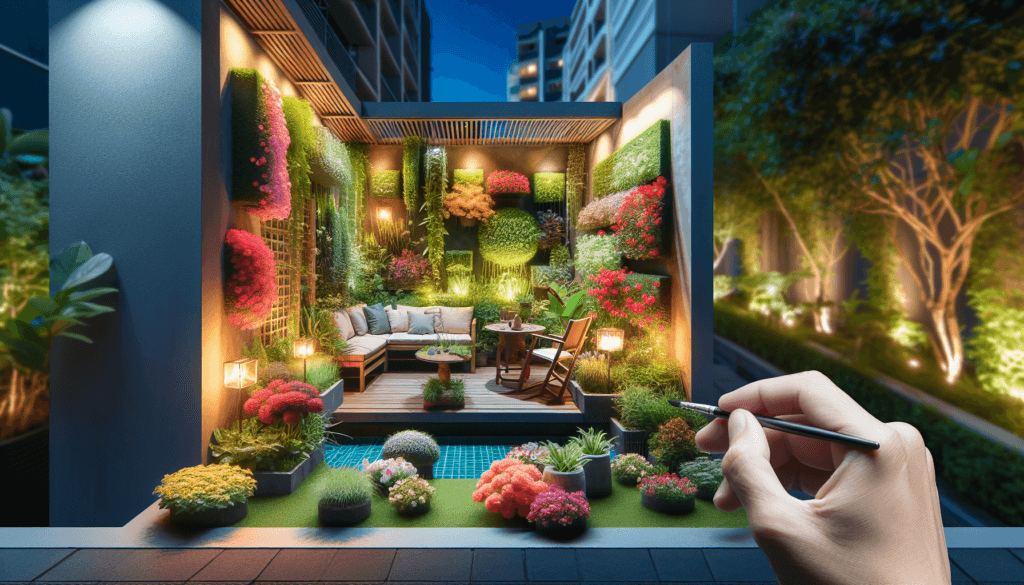
Maintaining a Small Garden
Regularly Prune and Trim Plants
Regular pruning and trimming are essential for maintaining the health and appearance of plants in a small garden. Monitor the growth of your plants and prune them as needed to maintain their shape, size, and overall structure. Remove dead or diseased branches to prevent the spread of disease and increase airflow. Trim plants that have become overgrown or are encroaching on other plants’ space. Regular pruning and trimming will help keep your small garden neat, tidy, and in optimal condition.
Monitor and Adjust Watering Needs
Monitoring and adjusting the watering needs of plants in a small garden is crucial to prevent overwatering or underwatering. Each plant has specific watering requirements, depending on its species and the prevailing weather conditions. Check the soil regularly to ensure it remains moist but not waterlogged. Adjust the watering schedule accordingly, taking into account factors like rainfall and humidity. Water plants deeply and infrequently to encourage deeper root growth. By monitoring and adjusting watering needs, you can promote healthier and more resilient plants in your small garden.
Implement Organic Pest Control Methods
Pest control is an important aspect of maintaining a small garden. Instead of relying on chemical pesticides that can harm beneficial insects and the environment, implement organic pest control methods. Encourage natural predators like ladybugs, lacewings, or birds to control pests such as aphids or slugs. Use physical barriers like netting or row covers to protect plants from pests. Incorporate companion planting techniques, such as planting marigolds to deter pests. Regularly inspect plants for signs of pests or diseases and take appropriate action if necessary. By implementing organic pest control methods, you can maintain a healthy and balanced ecosystem in your small garden.
Keep the Garden Clear of Clutter
In a small garden, keeping it clear of clutter is essential to maintain a clean and organized look. Regularly remove fallen leaves, debris, or weeds to prevent them from accumulating and smothering your plants. Store garden tools and equipment in designated storage areas to avoid cluttering the garden space. Avoid overcrowding the garden with too many decorations or plants, as this can make it feel busy and overwhelming. By keeping your small garden clear of clutter, you can create a tranquil and visually appealing outdoor oasis.
Provide Adequate Nutrients through Fertilization
To ensure the health and vitality of plants in a small garden, it is important to provide them with adequate nutrients through fertilization. Choose a balanced organic fertilizer that suits the needs of your plants. Apply fertilizers in accordance with the manufacturer’s instructions, taking into account the specific requirements of each plant. Avoid overfertilizing, as this can lead to nutrient imbalances or burn the plants. Regularly monitor the condition of your plants and adjust the fertilization regimen if necessary. By providing adequate nutrients through fertilization, you can promote robust growth and vibrant blooms in your small garden.
Including Personal Touches
Display Personal Collections or Souvenirs
Including personal collections or souvenirs in your small garden adds a touch of sentimentality and reflects your unique personality. Display items such as vintage garden tools, antique pots, or sentimental ornaments that hold personal significance. Group them together in a designated area or place them strategically throughout the garden to create moments of surprise and delight. By displaying personal collections or souvenirs, you can infuse your small garden with cherished memories and personal history.
Incorporate Favorite Colors or Themes
Incorporating favorite colors or themes in your small garden allows you to create a space that resonates with your personal style and preferences. Choose plants, accessories, or decorative elements that align with your favorite colors, whether it be vibrant hues or soothing pastels. Consider incorporating a specific theme, such as a cottage garden or a Japanese-inspired garden, to create a cohesive and harmonious design. By incorporating favorite colors or themes, you can create a small garden that feels like a reflection of your individual taste and personality.
Create a Relaxing Meditation or Yoga Space
A small garden can provide the perfect setting for relaxation, meditation, or yoga. Set aside a quiet corner and create a designated space with comfortable seating, meditation cushions, or a yoga mat. Surround the area with plants that have calming scents, such as lavender or jasmine, to enhance the ambiance. Incorporate elements of water, such as a small fountain or a birdbath, to create a soothing soundscape. By creating a dedicated meditation or yoga space, you can transform your small garden into a peaceful retreat for relaxation and self-reflection.
Add Personalized DIY Crafts or Projects
Adding personalized DIY crafts or projects to your small garden allows you to showcase your creativity and add a personal touch to your outdoor space. Consider creating hand-painted signs, stepping stones with personalized messages, or homemade bird feeders. Arrange the crafts or projects throughout the garden to create moments of interest and whimsy. By incorporating personalized DIY crafts or projects, you can infuse your small garden with your own artistic flair and make it truly unique.
Use Fragrant Plants to Evoke Memories
Fragrant plants have the power to evoke memories and create an immersive sensory experience in your small garden. Choose plants with intoxicating scents, such as roses, jasmine, or lavender, to stimulate the olfactory senses. Place them strategically near seating areas or pathways where their fragrance can be enjoyed. The aroma of these plants can transport you to another time and place, evoking fond memories and creating a serene and uplifting atmosphere in your small garden.
In conclusion, designing a small garden requires careful consideration and creativity. By choosing the right plants, creating functional zones, maximizing space with smart design, and enhancing the garden with color, texture, lighting, and decorative elements, you can transform a small outdoor space into a beautiful and vibrant oasis. Remember to maintain the garden regularly and add personal touches to make it a reflection of your own style and personality. Whether it’s enjoying a cup of tea in a cozy seating area, attracting wildlife with native plants, or creating a serene meditation space, a well-designed small garden can bring joy and tranquility to your life.
